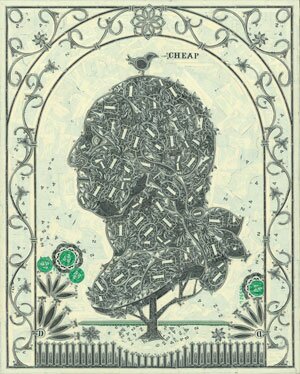CULTURE- ART FEATURE- Historical re-vision: Colonial iconoclasm at SSG

I confess when I first learned Second Street Gallery's new exhibition was called "The Colonial Show," I felt knee-jerk resistance. Growing up in Virginia, I'd been force-fed a steady diet of red brick, Thomas Jefferson, and tri-cornered hats– to the point of never wanting to swallow any of it again (sacrilege in the ‘ville, I realize).
Nevertheless, I dutifully trudged down to SSG, where I discovered Second Street's intrepid director, Leah Stoddard, has curated the exhibition herself. Stoddard admits she, too, grew up thinking colonialism was "uncool," but she says that in the past few years she's noticed colonial figures popping up in cutting-edge artwork. Intrigued, she decided to put together the current exhibition to explore how artists are addressing this period of American history.
The six artists in the show— Calvin Burton, Ian Davis, Omer Fast, Matthew Fisher, Mark Wagner, and Kate Woodliff— each offer a distinct aesthetic, but they share an impulse to defrock colonialism of its hallowedness. Burton's large painting "The Dome" exemplifies this iconoclastic attitude. Here Monticello's familiar top round is no longer pristine white but garish Pepto-Bismol pink, while much of the rest of the iconic architecture is eye-shocking chartreuse.
Burton's exuberant brushwork, incorporating drips and veering into abstraction, emphasizes the artist's disregard for the tidy hands-off deference often accorded all things Jefferson. He even imposes energetic horizontal swaths of grass green, teal, and orange directly on top of the image of the building at the center of the painting.
Davis, on the other hand, uses stylized, controlled structure and repetition in his paintings to illustrate the impractical absurdity of unarmed Redcoats marching across dreary winter landscapes. Fisher also examines the inanity of pompous military posturing in his ceramic figures and brilliantly hued paintings. In Fisher's work, solitary uniformed figures appear lost and without purpose in their spit-and-polish finery.
Woodliff's kitsch-fueled fabric collages and Fast's often hilarious "Godville Portraits," mimicking museum presentations of historical figures but recounting the lives of re-enactors, offer rewards, but the show's strongest pieces are Wagner's amazing collages created from cut-up dollar bills. Technically staggering, the elaborate compositions humorously toy with George Washington as the father of our money-oriented culture, as Wagner willfully plays the scofflaw by illegally defacing U.S. currency.
Each of these artists turns a fresh eye to American colonialism and exposes how risky it is to put the past on a pedestal without fully examining its consequences.
"The Colonial Show" is on view at Second Street Gallery through January 26. 115 Second St. SE (in the Charlottesville City Center for the Arts). 977-7284.
#